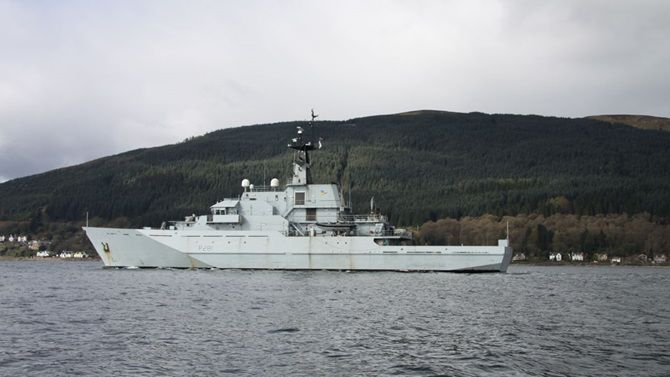Royal Navy Minehunting Crew Reassigned to Fishery Patrol

Minehunting crews are returning to fishery duties after a decade's absence so that their counterparts can bring a new generation of patrol ships into service.
As of tomorrow, sailors who normally crew Hunt-class ships are the new ship's company of HMS Tyne, whose sailors are heading to Scotland to crew Tyne's successor, HMS Forth.
Under Project Jicara, two crews from Portsmouth's 2nd Mine Countermeasures Squadron will join the Fishery Protection Squadron to man and operate one of the River-class vessels while their own Hunt class ships are out of action undergoing major engine changes.
Normally Hunt crews rotate around the class of nine ships – two of which are based in Bahrain as part of the RN's permanent minehunting presence in the Middle East. And when they've been called upon in the past to conduct fishery patrols, they've done so in their own craft.
Now they'll have to do so in ships more than twice the size they are used to, several knots faster – although the act of minehunting takes place at crawling pace – two decades newer and with considerably more comfortable and spacious living quarters. They also have to swot up on fish species . . . and grow used to their odour.
It is the duty of the fishery squadron – nicknamed the Cod Squad – to ensure that vessels fishing in and around the UK's waters are sticking to official quotas to prevent fish stocks being exhausted. "The opportunity to man and operate an offshore patrol vessel for a Hunt-class crew is quite unique," said Lt Alex Coleman, Executive Officer of MCM2 Crew 6, who've only recently returned from the Gulf.
"This is a great chance for many of our sailors to broaden their skills on different machinery and shows just how adaptable and employable the guys really are."
Coxswain PO(D) Toby Jones added: "For some there is very little difference in their every day role, but for others, especially the engineers, their roles onboard and the equipment they will operate is very different."
To ensure the safe transition, the mine crew have spent a lot of time working alongside the Fishery Protection Squadron both in harbour and at sea to get used to the ships, their equipment, routines and their roles and responsibilities and gaining the qualifications required.
"The prospect was a bit daunting at first, but having completed my training in HMS Tyne, 2017 is going to be a great opportunity to learn more about the different roles of the Royal Navy and work with new equipment," said ET(WE) Danny Bowles.
Mine warfare expert LS 'Eddie' Edmonson added: "Pretty much the entirety of a mine warfare rating's career is spent in minehunters operating in the Gulf. This is a great opportunity for me and the other lads to do something different, expand our skills and maybe get a run ashore somewhere different."
He and his crewmates will be in charge of Tyne until the end of the year, when they'll return to the mine world, MCM2 Crew 7 (currently aboard HMS Ledbury) will take over HMS Mersey, allowing the latter's crew to move onboard HMS Trent.
This article appears courtesy of Royal Navy News and may be found in its original edition here.
